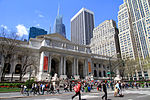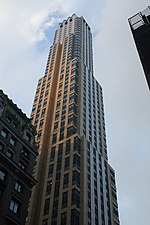452 Fifth Avenue

452 Fifth Avenue (also the HSBC Tower and formerly the Republic National Bank Building) is an office building at the southwest corner of Fifth Avenue and 40th Street in the Midtown Manhattan neighborhood of New York City. The building includes the 30-story, 400-foot (120 m) HSBC Tower, completed in late 1985 and designed by Attia & Perkins. The 10-story Knox Building, a Beaux-Arts office building designed in 1902 by John H. Duncan, is preserved at the base of the skyscraper. 452 Fifth Avenue faces Bryant Park immediately to the north. The HSBC Tower is designed with a glass facade, which curves around the Knox Building to the north; a similar curved tower across Fifth Avenue was never built. The Knox Building's facade remains largely as it was originally designed, with decorated limestone cladding, a cornice above the sixth floor, and a mansard roof. The Knox Building is a New York City designated landmark and is on the National Register of Historic Places. Internally, the tower is tied into the stories of the Knox Building. The Knox Building was erected between 1901 and 1902 for Edward M. Knox, who operated the Knox Hat Company and leased out several stories to office tenants. In 1964, the Knox heirs sold the building to a group that founded the Republic National Bank of New York and used the building as the bank's headquarters. The bank acquired the neighboring lots in the 1970s and hired Attia & Perkins to design a tower to house its new world headquarters, which would wrap around the Knox Building. The tower was expanded in the 1990s and sold to the investment bank HSBC. In October 2009, HSBC Holdings sold the building to Midtown Equities and Israeli holding company IDB Group, the latter of which passed the building to a subsidiary, Property & Building Corporation (PBC). HSBC continued to lease back its space in the building until 2022, when the bank announced it would relocate.
Excerpt from the Wikipedia article 452 Fifth Avenue (License: CC BY-SA 3.0, Authors, Images).452 Fifth Avenue
5th Avenue, New York Manhattan
Geographical coordinates (GPS) Address External links Nearby Places Show on map
Geographical coordinates (GPS)
| Latitude | Longitude |
|---|---|
| N 40.752222222222 ° | E -73.9825 ° |
Address
HSBC Tower
5th Avenue 452
10018 New York, Manhattan
New York, United States
Open on Google Maps











